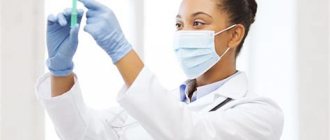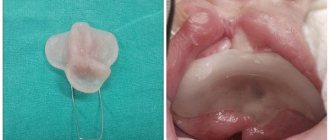How does infection occur?
The content of the article
Sexually transmitted diseases are a group of infections that can be transmitted through sexual contact: vaginal, oral or anal. In rare cases, infection occurs when using contaminated items - wet towels, sponges or intimate accessories.
Factors that increase the risk of contracting sexually transmitted diseases include having a large number of sexual partners, not using condoms, and substance abuse, which increases risky sexual behavior.
Refusal of condoms
It has been proven that people aged 15 to 24 years, with low financial status, living in large urban agglomerations, as well as homosexual men who do not remain in permanent relationships most often suffer from sexually transmitted diseases.
Diagnosis of sexually transmitted diseases
Before treatment of sexually transmitted diseases, diagnostics are carried out. The symptoms are similar in the vast majority of cases, but they are caused by different types of microorganisms. At the first suspicion of infection, it is recommended to immediately consult a doctor. Diagnosing such pathologies is a rather complex process that requires a professional approach. In laboratory conditions, a study of the samples taken is required, which makes it possible to accurately determine the pathogen, prescribe adequate therapy and begin treatment in a timely manner.
Diagnosis of sexually transmitted diseases includes several stages.
- A smear is taken from the vagina or urethra to identify the pathogen that caused the development of an STD.
- Serological research - using PIF and ELISA methods, antibodies to pathogens are determined.
- Cultural diagnosis - the pathogen is artificially grown to determine susceptibility to antibiotic medications.
- Polymerase chain reaction - helps to identify DNA fragments of the pathogen. Recognized as the most accurate way to diagnose STIs.
Gonorrhea
Gonorrhea is caused by the gram-negative bacteria Neisseria gonorrhea. Infection almost always occurs through sexual contact. A special case is when a sick mother infects her child during childbirth. Extrasexual infections are extremely rare and can occur as a result of using contaminated items, such as a damp sponge or towel (the bacteria can survive on them for 3 to 24 hours).
Gonorrhea in women is most often asymptomatic, but purulent discharge, pain in the lower abdomen, burning in the vagina, menstrual irregularities and heavy menstruation may occur.
Pain in the lower abdomen
Burning genitals
In men, the disease manifests itself in the form of purulent discharge from the urethra, burning sensation and pain when urinating.
Sexually transmitted diseases
- HIV and AIDS
- Gonorrhea, or clap
- Chlamydia
- Syphilis
- Condylomas or bleeding warts
- Herpes
- Candidiasis
- Hepatitis
- Pubic lice
- Scabies
- Trichomoniasis (or trichomoniasis)
HIV and AIDS
HIV - Human Immunodeficiency Virus (HIV - Human Immunodeficiency Virus) is a virus that destroys the human immune system. This virus penetrates the cell and has the ability to change its structure in such a way that upon further division, each new cell carries HIV. Over the years, the virus destroys so many lymphocytes that the resistance of the human body decreases, and the infected person is exposed to various diseases. Because HIV can mutate, it is difficult to kill with drugs. AIDS - Acquired Immune Deficiency Syndrome (English: AIDS - Acquired Immune Deficiency Syndrome) - is the final stage of HIV infection, which a person becomes ill with several years after infection. Infection. HIV is transmitted through seminal fluid (sperm), vaginal secretions during unprotected sexual intercourse, or through blood. Sharing needles and syringes when injecting drugs poses a high risk of infection. There is also a risk of infection during organ transplants or blood transfusions. Viral infection can also be transmitted from mother to child during pregnancy, childbirth and breastfeeding. In Western countries, 10-20% of children from mothers exposed to viral infection became infected. HIV is most easily transmitted to another person during the initial period of infection, as well as during the stage of AIDS. HIV is not transmitted through everyday interactions. It is not transmitted by kissing, shaking hands, or visiting the toilet or bathhouse. They do not transmit the infection. Symptoms and course of the disease. In some people (about 1/3 of those infected), the first symptoms appear 1-8 weeks after becoming infected. Signs of the disease may include fever, sore throat, headache, joint pain, eczema and swollen lymph glands. The first symptoms disappear on their own after a few weeks. After an initial period of early symptoms or even no symptoms, the virus continues to spread in the body, but the person may feel healthy. As the disease progresses, swelling of the lymph nodes in the neck, collarbones and under the arms becomes noticeable. The general condition is deteriorating. Fever, diarrhea and night sweats are common. The time at which these symptoms appear is very individual. 10 years after infection, symptoms of the disease appear in approximately 50% of those infected. During the AIDS stage, a person’s immune defense is weakened, so he is affected by various inflammatory diseases (for example, tuberculosis) and tumors develop (for example, Kaposi’s sarcoma). The patient's condition depends on what diseases he becomes susceptible to and how they can be treated. Examination. It is impossible to make a diagnosis based on the symptoms, since many other diseases have the same symptoms and almost no one infected shows early symptoms. The only way to detect a possible infection is to get tested. HIV infection is determined by a blood test. Since the process of antibody formation is examined, the presence of infection does not appear immediately, but only after 2-4 months. A completely reliable analysis result can be obtained 6 months from the moment of possible infection. The results of the analysis are confidential information, and they are reported only to the person being studied. It takes 1-2 weeks to receive analysis results. You can get tested anonymously in many medical institutions. Treatment. According to the law on infection, examination of AIDS patients, their treatment and medicines are free.
It is not yet possible to cure AIDS. However, recently more and more effective drugs for AIDS patients have been developed. Life expectancy after the disease has increased, and a normal lifestyle can be maintained for a longer period of time. Thus, we can say that at present AIDS is a long-term chronic disease. There is no need to stop sexual activity even if you are infected with HIV. The most important thing is to remember responsibility in all situations and, of course, engage in only safe sex. The law obliges to ensure that both the HIV carrier and his partner adhere to the requirements of safe sex. back to contents
Gonorrhea, or clap
Pathogen: Gonococcus bacterium Gonorrhea is infected through sexual intercourse through the vagina, anus or mouth. From the hands the disease can spread to the eyes. Infection of the rectum also occurs. A newly born child can become infected through the reproductive organs. Symptoms usually appear within a day or a couple of weeks after infection. Symptoms in women. Leucorrhoea (vaginal discharge) that may appear normal but is heavier than usual. There may be a burning sensation when urinating. Pain in the lower abdomen and fever may be a sign of inflammation that has spread to the ovaries. If gonorrhea infection occurs through the mouth, the throat may feel painful, like a sore throat, or there may be no symptoms. Very often, in women, the symptoms of the disease appear very weakly or not at all. Symptoms in men. Burning sensation when urinating and frequent urge to urinate. Yellowish-greenish discharge from the urethra. Painful erection. When infected through the mouth, a sore throat occurs. In men, gonorrhea can also occur without symptoms. Examination. Samples for analysis are taken with a cotton swab from the urethra, cervix, pharynx and rectum. Treatment. Gonorrhea is treated with antibiotics. According to the law on contagious diseases, tests, treatment and medicines are free in health centers and city venereal clinics. In women, gonorrhea, if left untreated, can lead to inflammation of the oviducts. This leads to childlessness. In men, advanced disease can cause inflammation of the testes, which can also cause childlessness.
back to contents
Chlamydia
Causative agent: Chlamydia bacterium Currently, chlamydia is the most common sexually transmitted disease. Chlamydia is transmitted sexually. A newborn child can become infected through the reproductive organs. Symptoms appear approximately 10-14 days after infection. Symptoms in women.
75% of women infected with chlamydia do not show symptoms.
Unusual vaginal discharge may be a sign of infection. Minor bleeding after sexual intercourse or between periods. Itching and burning when urinating. Pain in the lower abdomen and sacral area. In case of inflammation of the rectum, slight bleeding or mucus discharge. Symptoms in men.
Among men, approximately 25% have no symptoms.
The most common symptom may be a grayish, curd-like discharge from the urethra in the morning. Mild burning sensation when urinating. When the rectum becomes inflamed, slight bleeding or mucus may appear. Examination.
Samples for analysis are taken from the urethra, cervix and rectum. The presence of infection is not detected immediately; tests must be postponed for approximately 10 days after possible infection. Results can be found out in about a week. If chlamydia spreads into the fallopian tubes, it can cause a blockage (obstruction). The consequence may be childlessness or an increased risk of ectopic pregnancy. Adhesions that appear as a result of the inflammatory process cause pain in the lower abdomen. Men can develop very painful inflammation of the testis, which, in turn, leads to obstruction of the vas deferens and weakened fertility. Both men and women may experience joint pain as a complication after chlamydia. Chlamydia that is not developed during pregnancy can cause inflammation of the baby's eyes and respiratory tract.
back to contents
Syphilis
Syphilis is a slowly developing common infection, the initial symptoms of which often go unnoticed. If left untreated, syphilis can lead to death. Syphilis is transmitted during sexual intercourse, oral sex, or during pregnancy from mother to child. Symptoms
The incubation period for the development of the disease after infection lasts 3-6 weeks.
Upon its completion, so-called so-called sore throats appear at the site of infection on the genitals, rectum or mouth. primary ulcers. They are small, purulent and non-painful and heal slowly over several weeks. About a week after their appearance, the lymph nodes in the groin enlarge and become hard, but no pain is felt. In women, the labia of the vulva may also become swollen. Bacteria spread throughout the body through lymphatic and blood vessels. Approximately 2-4 months after infection, symptoms of the second period appear. Common symptoms may include headache, fever, and sore throat. Small rashes appear on the skin, as well as pimples, especially on the palms and soles of the feet. Hair loss may occur. Pimples may appear on the mucous membrane of the genital organs and around the anus. The above symptoms disappear without treatment, approximately six months after infection, and the infection develops into the so-called. latent (hidden) period. In patients who have not been treated, symptoms of the second period of disease development on the skin and mucous membranes may, however, appear repeatedly during the first two years after infection. During this two-year period, syphilis is contagious. Among those who had syphilis and did not treat it, 20-30% may develop the so-called syphilis after many years and decades. late syphilis, which affects the central nervous system and circulatory organs. Examination.
Syphilis is usually diagnosed based on symptoms.
A blood test detects syphilis two months after infection, and only after two years does untreated syphilis cease to be infectious. Treatment.
Treatment of syphilis is carried out with penicillin, which is administered by intramuscular injection for two weeks. The earlier the course of treatment begins, the more effective it is.
back to contents
Condylomas or bleeding warts
Iru or condyloma infection affects both men and women. A newborn can become infected during childbirth through the reproductive organs. Condylomas become infected through contact between mucous membranes, during regular or anal intercourse. The transmission of infection is facilitated by the presence of damage to the mucous membrane or an existing infection in the genital area. Infection can also occur during sexual intercourse, but condylomas in the mouth are extremely rare. Symptoms in women.
The incubation period for condyloma lasts from several weeks to a year.
After it, small light pink or white dots appear on the mucous membrane of the genital organs, which can develop into warts similar in shape to a cauliflower shoot. Warts range in size from one millimeter to several centimeters. In women, warts grow in the pubic lips, vagina, cervix, perineum, anus and at the opening of the urethra. Changes in the mucous membrane may simply consist of thickening of the skin or mucous membrane without the appearance of warts. Sometimes the symptom is painful itching. Most often, condyloma occurs without symptoms and is detected during general examinations. Symptoms in men.
The incubation period is the same as for women.
In men, condyloma warts appear either under the foreskin, on the penis, the head of the penis, near the opening of the urethra, or around the anus. In the oral cavity, condyloma-warts are either light or the color of the mucous membrane. Quite often in men, condyloma occurs without symptoms and is invisible to the eye. Examination.
Condyloma in women is detected during a gynecological examination.
Analysis of a sample of exfoliated tissue taken from the cervix is often used, as well as colposcopy (observation of the reproductive organs through a magnifying device). Condyloma in men is diagnosed by external examination, as well as through a magnifying device, as with colposcopy. Treatment.
There are many treatment options, the choice of which is influenced by the size, number and location of warts. They can be lubricated, treated by freezing, removed by laser or electrocoagulation. Both men and women should be monitored in the future, as there is a danger of cell modification and a relatively high risk of relapse of the disease. The condyloma virus can cause cancer on the cervix. A small percentage of untreated cervical condyloma develops into cancer over the years. Therefore, medical supervision after treatment of the disease and annual testing are very important.
back to contents
Herpes
Pathogen:
There are 2 types of herpes simplex virus (HSV, “Herpes simplex”).
The first type (HSV-1) affects mainly the skin and mucous membrane of the lips (causes herpes labialis or rash on the lips), eyes, nose and other organs, and the second (HSV-2) mainly affects the genitals. This is genital herpes. Currently, due to the widespread prevalence of oral-genital contacts, there are increasingly cases where genital herpes is also caused by the HSV-1 virus. After the initial infection, the virus penetrates the lymph nodes, where it remains in a latent form. Often the virus remains in that state without causing further symptoms, but in some infected people it reactivates painfully often, even several times a year. The disease is transmitted during sexual intercourse, as well as through oral sex. Herpes can infect the fetus during pregnancy of an infected woman, or the newborn becomes infected during childbirth. The result can be dangerous brain inflammation. If the mother has herpes blisters at the time of birth, the birth is performed by caesarean section. Symptoms
The incubation period after infection ranges from several days to a week.
The first symptoms are itching and pain at the sites of infection. After a couple of days, bubbles filled with liquid appear at the sites of infection. In women, blisters may appear on the labia, perineum, around the anus, in the vagina, or on the cervix. In men, they appear on the penis, on the head of the penis or in the anus. Very often, primary infections are accompanied by a violent manifestation of the disease - poor health, headache and fever. The glands in the groin are enlarged almost all the time. The blisters burst after a few days, leaving painful sores that then crust over. Symptoms of a primary infection can last up to two weeks. After a primary infection, the disease always remains, but only in a latent form. The frequency of recurrence of symptoms and the degree of their pain are very individual. With repeated herpes, the manifestation of the disease is usually weaker, and general health does not worsen. Local symptoms are the same as with the primary infection, but they heal faster or in about a week. Re-infection is often caused by stress. Relapse of the disease also appears in connection with other infectious diseases, during menstruation or after mechanical irritation (for example, violent sexual intercourse). Examination.
The sample is taken from the vial onto a cotton swab.
The test result can be obtained within a week. Treatment.
Treatment of genital herpes is a difficult task due to its lifelong presence in the body and the lack of drugs that have an effective effect on it. The most commonly used drugs for treatment today are from the group of nucleoside analogues. In addition, during the acute period, specific anti-herpetic immunoglobulin is used. In complex treatment, immunostimulants, vitamins, antihistamines and other drugs are used. When the interval between relapses is at least 2 months, vaccination is carried out with a hermetic vaccine. After 6 months, a repeat course is carried out. The vaccination is repeated 4-6 more times. The use of the vaccine allows you to increase the intervals between relapses and reduce their manifestations.
back to contents
Candidiasis
Pathogen: Yeast-like fungus of the genus Candida.
This disease is popularly called “thrush”.
It is caused by yeast-like fungi. Candidiasis is a common infection. Fungi can be found in the vagina of many women who do not have any complaints. They enter the genital tract mainly from the intestines and through contact with patients. The development of an inflammatory reaction during candidiasis (candidal colpitis) is facilitated by factors that reduce the body’s immunity, such as diabetes mellitus, lipid metabolism disorders, and diseases of the digestive system. In pregnant women, candidiasis is detected more often due to the numerous changes occurring in a woman’s body at this time. Long-term use of hormonal contraceptives, broad-spectrum antibiotics, corticosteroids and some others also plays a role. “Thrush” is a manifestation of superficial candidiasis of the skin and visible mucous membranes. With severe immunity disorders, lesions of the urinary tract (cystitis, urethritis), lungs (bronchitis, pneumonia), and intestines (dysbacteriosis) can develop. Symptoms in women.
With candidiasis, women usually complain of white, cheesy discharge and itching.
The disease lasts a long time and may be accompanied by periods of exacerbation (during menstruation, hypothermia, etc.) and subsidence of complaints. Symptoms in men.
In men, the fungus causes itching in the genitals, slight redness on the head of the penis and swelling of the foreskin.
Diagnosis, as a rule, does not present any difficulties. Candidiasis is easily detected in routine vaginal smears. In some cases, cultural (seeding secretions on nutrient media) and other methods are used. When the disease persists, sensitivity to various antifungal drugs is determined, which makes it possible to prescribe the most effective agent. Treatment.
Nystatin, levorin, boric acid and borax (sodium tetraborate) were previously widely used to treat candidiasis. Currently, there are a number of more effective and less toxic agents.
back to contents
Hepatitis
Hepatitis means inflammation of the liver caused by a virus. The most common types of hepatitis are hepatitis types A, B and C.
Hepatitis A
Hepatitis A infection occurs when fecal particles containing the virus enter the mouth of another person. Most often, infection occurs through transmission through water and food. If fecal particles enter the oral cavity during alternating anal and oral sex, they can lead to hepatitis infection. Hepatitis A is the least dangerous of all hepatitis. The infection does not lead to chronic inflammation of the liver and cirrhosis, nor does it lead to liver cancer. The disease often begins with fever, muscle pain, general malaise and diarrhea. After about a week, the urine becomes dark and the skin and whites of the eyes turn yellow. The disease goes away on its own in approximately 2-4 weeks.
Hepatitis B
Hepatitis B infection occurs through blood (for example, through drug syringes) or products containing blood through sexual contact (sperm, uterine discharge), or the infection is transmitted from mother to child during pregnancy and childbirth. Only a small proportion of those infected become infected with symptoms. These symptoms are the same as for hepatitis A. Among those infected, some remain permanent carriers of the virus. A small number of virus carriers develop cirrhosis or chronic liver inflammation within 10-20 years. Some carriers of active chronic hepatitis are cured by taking alpha interferon. If you have hepatitis B, it is possible to use a series of three vaccinations for treatment (first vaccination, second one a month later, third vaccination six months later).
Hepatitis C
Hepatitis C infection occurs through the blood. The most common route of infection is the use of syringes and needles when consuming drugs. Half of hepatitis C virus carriers develop an active form of chronic liver inflammation. Chronic hepatitis C increases the risk of liver cancer. Treatment with alpha interferon can cure approximately 20% of patients with chronic hepatitis C.
back to contents
Pubic lice
Pathogen: Flesh-colored flat louse measuring 1-3 mm.
The pubic louse sucks blood and lays eggs on the pubic hair.
Pubic lice infestation occurs through skin-to-skin contact and bedding. Symptoms.
Symptoms appear 1-3 weeks after infection.
Skin irritation and itching in the external genital area. Treatment.
At the pharmacy you can buy a hexide solution (Desintan) without a prescription, which is applied to the skin in the pubic area for a day. A week later the procedure is repeated. Underwear and bed linen are changed.
back to contents
Scabies
Pathogen: Scabies mite size 0.3-0.5 mm.
Scabies spreads through skin-to-skin contact.
Symptoms.
Itching appears 3-6 weeks after infection.
With scabies acquired as a result of sexual contact, signs of the disease are especially evident in the lower abdomen, groin and thighs. The itching intensifies in the evening. Small reddish pimples appear on the skin. As a result of scratching, the skin may become inflamed and pustules may appear on the fingers, hands and penis. Traces of scabies mite movement may be found. Treatment.
A hexide solution (Desintan) is rubbed over the entire body. After application, the medicine is washed off after 12-14 hours. Underwear and bed linen are changed. The medicine is reused after a week. The partner and family members are treated at the same time, even if they show no signs of illness.
back to contents
Trichomoniasis (or trichomoniasis)
Trichomoniasis (or trichomoniasis) is one of the most common sexually transmitted diseases. It is caused by Trichomonas vaginalis -
a microscopic pathogen capable of independent movement with the help of flagella and an undulating membrane. Trichomonas very often accompanies other genital tract infections - chlamydia, gonococci, viruses, etc. Infection, as a rule, occurs only through sexual contact. The incubation period is 5-15 days. The development of the disease is facilitated by various diseases of the genital and other organs, accompanied by metabolic disorders, decreased immunity, hormonal disorders, and disruption of the vaginal flora, which reduces its acidity. Trichomonas actively reproduce during menstruation also due to changes in the vaginal environment. The pathogen lives mainly in the vagina and lower cervix. There is no immunity to the disease. There are several forms of the disease: fresh (in turn divided into acute, subacute and torpid, i.e. low-symptomatic), chronic and carriage of Trichomonas, in which there are no symptoms in the presence of the pathogen in the vagina. In acute and subacute forms, patients complain of heavy vaginal discharge, itching and burning in the external genital area. If the urethra is damaged, there is a burning sensation and pain when urinating. The torpid form is not accompanied by complaints of leucorrhoea, itching, or they are only slightly expressed. The chronic form of the disease is characterized by a long course and periodic relapses that occur under the influence of various provoking factors: general and gynecological diseases, hypothermia, violations of the rules of sexual hygiene, etc. The severity of complaints can vary widely. Diagnosis of the disease is based on complaints, examination data and laboratory results of smears from the vagina, cervix and urethra. In some cases, seeding of material is used. Treatment of trichomoniasis. During this period, sexual activity is prohibited. Treatment of the husband or sexual partner, treatment of concomitant diseases is mandatory. Currently, there are a large number of anti-trichomonas drugs.
back to contents
Syphilis
Syphilis is caused by a spirochete bacterium. Infection occurs mainly through sexual contact (vaginal, oral, rectal). It is possible to become infected even by kissing if bacteria are present on the mucous membrane of a person’s mouth
In half of people, syphilis does not produce any symptoms, but even in its latent form it affects health and, if left untreated, damages the nervous and cardiovascular systems, bones, joints, causes mental disorders and blindness.
The disease can lead to the appearance of symptoms - at the first stage an ulcer appears on the genitals or vulva, then a rash on the palms and soles of the feet, which goes away on its own. Then the disease continues hidden.
Joint damage
Rash on feet
Complications
Ignoring treatment can lead to various complications. The worsening of a sexually transmitted disease in a woman can lead to the appearance of a number of vaginal ailments: salpingitis, endometritis, adnexitis, etc. In a man, it can provoke the development of vesiculitis, urethritis or prostatitis. Both sexes are at risk of reproductive dysfunction leading to infertility. Pregnant women with chlamydia and herpes are at risk of premature, spontaneous miscarriage. For men, STIs are fraught with changes in the qualitative composition of sperm and a significant decrease in male potential.
Chancroid
Venereal ulcers, also known as soft ulcers, are more common in men than women. The cause of formation is the bacteria Haemophilus ducreyi. The main symptom of the disease is a painful ulceration on the genitals, which looks like a lentil grain with a bright red border. The disease is accompanied by swollen lymph nodes.
Peptic ulcer infection is rare in developed Europe; it is more often diagnosed in developing countries, and, alas, in Russia.
Nongonococcal urethritis (NGU)
Non-gonococcal urethritis is more common in women. It is provoked in most cases by the bacterium chlamydia - Chlamydia trachomatis (30% of cases), less often by vaginal trichomonas Ureaplasma urealyticum or Mycoplasma genitalium.
Symptoms that can occur in both men and women include frequent urge to overfill the bladder, pain and burning when urinating. In addition, women may experience unpleasant vaginal discharge and purulent discharge from the urethra in men.
Bladder fullness
Discharge
Basic measures to prevent STDs
Treating STDs is much more difficult than preventing them from occurring. A condom will not completely protect you from infection. But it significantly reduces the risk of infection. Therefore, use a condom every time you have sexual intercourse with a regular or new partner. Also, as a preventive measure for STDs, doctors recommend adhering to the following rules:
- Practice good hygiene regularly. Each person should have their own towel and underwear.
- Do not skip preventive examinations from specialists. A man should make an appointment with a urologist at least once a year.
- It is advisable not to change partners frequently, to be faithful to your spouse, and to avoid casual sexual contact.
- Boost your immunity in accessible ways. Even if the virus is in the blood, good immunity will prevent it from actively manifesting itself.
As you can see, most sexually transmitted diseases are dangerous for both men and women. Some of them manifest themselves asymptomatically, which is the most dangerous thing, while others are accompanied by characteristic symptoms. The incubation period for STIs varies among men; for some infections it can reach a year. Therefore, it is recommended at any age to follow the rules for preventing STDs and not to miss preventive examinations with doctors. If you do develop an infection, do not hesitate to begin treatment as soon as possible.
If you don’t know where to go with a problem, call our clinic by phone. Specialists from the First Clinic of Orekhovo will help solve your health problems and answer any questions you may have. We can provide you with the necessary tests, tests, and hardware scans. There is no need to go anywhere or wait for a long time. To make an appointment, use the special form on the clinic’s website or call one of the contact numbers.
AIDS
AIDS is the final stage of infection with the human immunodeficiency virus (HIV). At the initial stage, the disease has no symptoms and can remain hidden for up to 10 years. Only at a late stage does AIDS cause an outbreak of diseases such as pneumonia, tuberculosis, and cancer.
The most common cause of infection is sexual contact. Infection can also occur through blood (for example, when using unsterile medical instruments) and during childbirth, when the mother infects her newborn baby.
People who have sex with multiple partners should be tested regularly for HIV, as the absence of symptoms can lead to unwitting infection of others.
Transmission routes
Infection with a specific disease can occur not only at the time of sexual intercourse - infection can also be indirect or domestic. In all cases, the culprit is pathogenic microorganisms that provoke the occurrence of a sexually transmitted disease that requires appropriate treatment. There is a risk of even accidental infection, so you should know how else infections of this kind are transmitted.
- When reusing medical instruments (catheters, syringes, etc.).
- By getting the pathogen into an open wound.
- Penetration through blood (contact with biological material of an infected person or transfusion).
- Contact with objects of an infected patient.
Genital herpes
HSV-2 is responsible for the development of genital herpes. It initially appears as small groups of painful blisters located around the genitals or anus. The blisters enlarge for 1-2 weeks and then burst and transform into small ulcers.
Treatment consists of oral antiviral medications and lubricating the affected areas with anti-inflammatory ointments.
Antiviral oral drugs
Pregnant women who are carriers of the herpes virus are advised to deliver by cesarean section to eliminate the risk of infection of the newborn.
Genital warts (HPV)
Genital warts are a consequence of a sexually transmitted disease caused by the human papillomavirus (HPV). The infection manifests itself in the form of papules and papillae located around the anus and genitals (both externally and internally, such as the vagina).
In more rare cases, condylomas can occur in the mouth - on the tongue, on the mucous membrane of the pharynx, larynx, and lips. Untreated condylomas eventually turn into cauliflower-like growths with a whitish tint. Papillomas can develop into cancer, since the papilloma virus is the main source of cervical cancer. In men, it causes penile cancer.
Treatment involves the use of antiviral ointments, creams and cryotherapy (freezing). In case of large lesions, laser removal is necessary.
Treatment of sexually transmitted diseases
After conducting a full examination and diagnosing a sexually transmitted disease, the specialist prescribes individual treatment therapy. Timely diagnosis guarantees effective treatment, preventing the disease from developing into a more severe (recurrent) form that is difficult to eliminate.
Therapeutic measures include local and general therapy using nitrofurans, antiseptic, antiviral, antibacterial, antiprotozoal and antimycotic drugs.
It is impossible not to note an important factor that should be paid special attention to - if an infection is detected, it is necessary to immediately examine the sexual partner, regardless of whether he has signs of infection. Otherwise, the therapy will not have the desired effect and re-infection will occur.
Molluscum contagiosum
Molluscum contagiosum is caused by the smallpox virus Poxviridae. In adults, it is most often transmitted sexually, less often through contact with infected objects. A characteristic symptom of this disease is the appearance of hard, translucent bulges of flesh-colored, pearl or yellow color, which are filled with a porous substance inside.
In men, the lesions are located on the penis, and in women - on the pubic mounds, labia, groin, and around the anus.
Lesions around the anus
Molluscum contagiosum is not dangerous and, as a rule, the changes caused by it disappear spontaneously after a few months. However, to avoid complications, treatment is recommended. The gynecologist and urologist prescribe special ointments and oral medications. Large lesions are excised using a laser or electric knife.
Complications and consequences
Any signs of sexually transmitted infections in men should be a reason to consult a doctor. Only a doctor can see a clear clinical picture, diagnose and prescribe treatment for STIs. It is dangerous not to be treated or seek medical help for STDs, as they can lead to serious complications:
- infertility and impotence;
- prostatitis, cystitis, urethritis and other diseases of the genitourinary system; the occurrence of adhesions and other pathological changes in tissues;
- development of malignant neoplasms;
- the disease can become chronic.
Trichomoniasis
Trichomoniasis is caused by the protozoan Trichomonas vaginalis. The main route of infection is sexual intercourse, less often contact with infected objects (especially toiletries that retain moisture, for example, towels, sponges).
Symptoms of trichomoniasis occur primarily in women (men are usually asymptomatic) and include yellow-green, frothy vaginal discharge, vaginal itching and burning, pain in the urethra, and a strong urge to urinate.
Hidden (asymptomatic) STIs
Signs of STIs in men in the early stages of the disease are not always noticeable. Some infections are asymptomatic. Because of this, they are detected too late, when treatment is no longer as quick and effective. Among the STDs that occur hidden for a long time, it is worth noting the following:
- Chlamydia. The development of the disease is provoked by bacteria penetrating inside the cells. During their stay in the human body, these bacteria destroy cells, releasing even more microorganisms into the blood. Chlamydia can damage both the external and internal genital organs at the same time. The respiratory system, heart, blood vessels, joints, teeth, vision, and hearing may suffer. The incubation period is 2-5 weeks. Chlamydia is asymptomatic in almost half of cases, and it is difficult to diagnose.
- HIV. The incubation period ranges from several weeks to 12 months or more. The initial stage passes without specific symptoms. But at this time, the virus infects human cells - in the process, the immune system gradually suffers. If a person constantly undergoes specially selected therapy, he will prolong his life by 10 years or more.
- HPV. The occurrence of papillomas on the genitals and the penetration of the virus into the body is a serious problem. Although in men the disease hardly manifests itself at all. The incubation period is long - from 3 weeks to a year or more. More often, HPV in men is detected during preventive examinations and visits to the doctor for other issues. First, single papillomas and condylomas appear on the genitals. Then they grow and form colonies. Papillomas can lead to the development of cancer. It is not possible to cure the disease completely, but it is possible to keep it in a “dormant” state. To do this, you must follow the recommendations of doctors.
- Another disease that is often asymptomatic in men is ureaplasmosis. Most men (according to some statistics, up to 70%) are carriers of this disease. They become infected not only through sexual contact, but also in everyday life. Ureaplasma destroys the cells lining the genitourinary tract from the inside. The process is accompanied by slight itching, discomfort, and heaviness in the lower abdomen. The incubation period of the disease is 2-4 weeks.
Genital candidiasis
Candidiasis, or fungal infection of the genitals, is most often caused by the yeast Candida albicans. People taking antibiotics and those whose skin is damaged by friction, various types of injury, or contact with detergents are more at risk of developing the disease.
In women, candidiasis causes unpleasant itching, burning and cheese-like discharge. The disease rarely affects men, but when it develops, it causes symptoms such as burning and itching of the genitals, red spots and blisters on the foreskin, and discomfort during sexual intercourse.
Prevention of sexually transmitted diseases
Many of the ailments transmitted during sexual intercourse have been known to mankind for centuries, while others appeared relatively recently, but all of them are equally dangerous for the body of a modern person. In order to avoid infection and further treatment of a sexually transmitted disease, it is necessary to take mandatory preventive measures to prevent its occurrence. The most effective means of preventing the penetration of pathogenic microorganisms is a condom. It is recommended to use for any type of sexual contact, remembering to put it on correctly.
If there was contact with a partner who is suspected of having an STI, and there was no contraceptive, you must immediately wash your genitals with an antiseptic solution (preferably no later than 2 - 3 hours).
It should be remembered that most sexually transmitted diseases transmitted through sexual intercourse may be asymptomatic. If you had sex with a new partner without using a barrier contraceptive, you should definitely visit a doctor to determine the presence of infection or its absence. If primary signs are detected, experts categorically do not recommend resorting to self-medication, as this is fraught with serious health problems.
Preventive measures must be taken constantly, providing reliable protection against the penetration of harmful microorganisms.
Scabies in intimate areas
Scabies in the intimate organs are caused by an external parasite, the human scabies mite. The first symptoms of the disease appear 1-2 months after the parasite begins to exist in the body. These include, first of all, severe itching of the skin - in men around the scrotum and penis, in women in the labia and pubic area.
Scabies in the intimate area
The parasites are invisible to the naked eye and reproduce by building in the tubules of the epidermis (itch corridors) where they lay eggs. Treatment of scabies involves lubricating the infected areas with special preparations.










